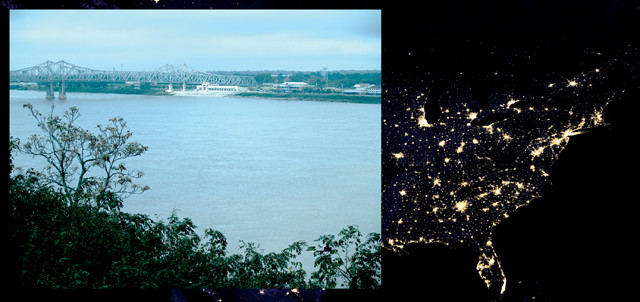
by Mary Caperton Morton Thursday, November 8, 2018

The Mississippi River is one of the most tightly flood-controlled rivers in the world. This may explain why homes and infrastructure are found right along the waterline, despite a history of highly destructive floods. New research based on satellite measurements of nighttime lights near rivers suggest people tend to stay near rivers with lots of built protection. Credit: above: NASA Earth Observatory images by Joshua Stevens, using Suomi NPP VIIRS data from Miguel Román, NASA's Goddard Space Flight Center; inset: Mary Caperton Morton.
Flooding is one of the most damaging natural hazards, so it’s no surprise that many people resettle farther from rivers after catastrophic flooding. A new study finds that the distance that people move from a given river depends on the degree of flood protection in place, with people rebuilding closer to rivers that offer high levels of structural flood protection, such as levees and dams, than they do to rivers without such protections.
In the new study, researchers used satellite measurements of nighttime light to evaluate human proximity to flood-prone rivers all over the world. By comparing relocation strategies after major flood events across 16 countries with varying socioeconomic profiles, the team explored “the long-term interrelationships between changes in human proximity to rivers, flood occurrences (inferred by flood damage) and flood protection levels,” they wrote in Science Advances.
Nighttime light data have been used to study socioeconomic activity in the wake of various natural disasters, but this is the first time they have been used to study human resettlement after flood events. The team found that flood fatalities and economic losses along rivers as diverse as the Mississippi River, the Limpopo River in South Africa and the Mekong River in Southeast Asia increase with proximity of human settlement to rivers. However, such trends are reduced when high levels of flood protection are in place.
“We found that societies with low protection levels tend to resettle farther away from the river after catastrophic flood events, and that the decrease in human settlements close to the river may have contributed to reduced exposure to future flood events,” said lead author Johanna Mård of Uppsala University in Sweden in a statement. “Conversely, societies with high protection levels show no significant changes in human proximity to rivers” after flooding events.
© 2008-2021. All rights reserved. Any copying, redistribution or retransmission of any of the contents of this service without the expressed written permission of the American Geosciences Institute is expressly prohibited. Click here for all copyright requests.